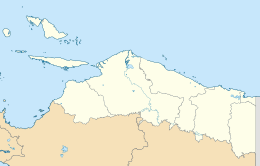Supiori Island
| Geography | |
|---|---|
| Location | Melanesia; Oceania |
| Coordinates | 0°45′S 135°30′E / 0.750°S 135.500°E |
| Archipelago | Schouten Islands |
| Area | 659 km2 (254 sq mi) |
| Highest elevation | 1,034 m (3392 ft) |
| Administration | |
| Province | |
| Regency | Supiori |
| Additional information | |
| Time zone | |

Supiori is an island of the Schouten Islands archipelago in Cenderawasih Bay, just west of Biak island in Papua Province, Western New Guinea, northeastern Indonesia.
Description
The island has a rugged terrain, largely covered in tropical rainforest. It is about forty kilometres (25 miles) long and 25 km (16 mi) wide, covering a total area of 659 square kilometres (254 square miles). Its highest point is 1,034 metres (3,392 ft) in elevation.
Principal settlements include Korido on the south coast and Yenggarbun on the north coast. South of Supiori lie the small coral islands Aruri (Insumbabi) and Rani. Before 1963, the island was part of the colonial Netherlands New Guinea. It comprises Supiori Regency within Papua Province.
History
The island was first sighted by Europeans by the Portuguese Jorge de Menezes in 1526. Menezes landed at Biak Islands, where he was forced to winter.[1] One of the first sightings was also made by the Spanish navigator Álvaro de Saavedra on 24 June 1528, when trying to return from Tidore to New Spain. The Schoutens were charted as Islas de Oro (Golden Islands in Spanish).
Its sighting was again reported by Spanish navigator Íñigo Órtiz de Retes in 1545. It was charted as Los Martires by the Spaniards, possibly because it was where Spanish navigator Hernando de Grijalva was murdered by his mutinied crew.[2]
Missionary Petrus Kafiar was a native of Supiori Island.[3]
References
- ^ Kratoska, Paul H. (2001). South East Asia, Colonial History: Imperialism before 1800, Volume 1 de South East Asia, Colonial History. Taylor & Francis. p. 56.[1]
- ^ Hamy, Ernst T. "Comentarios sobre algunas cartas antiguas de la Nueva Guinea para servir a la historia del descubrimiento de aquel país por los navegantes españoles (1528-1606)," translated by Martín Ferreiro and included in the work of Justo Zaragoza in Boletín de la Sociedad Geográfica de Madrid, tIV, primer semestre, 1878, p.44
- ^ Gerald H. Anderson (1999). Biographical Dictionary of Christian Missions. Wm. B. Eerdmans Publishing. pp. 349–350. ISBN 978-0-8028-4680-8.

